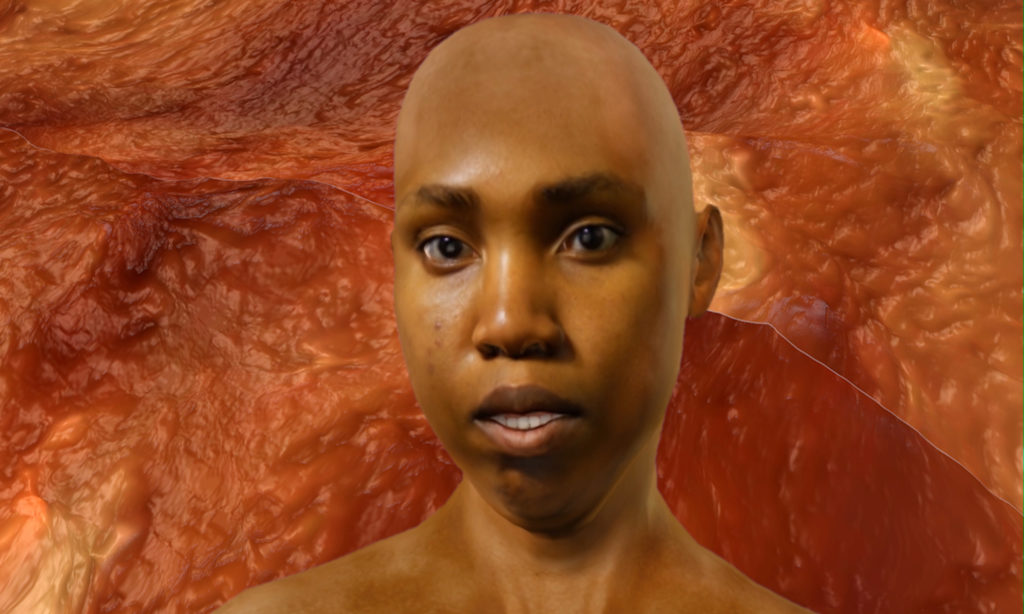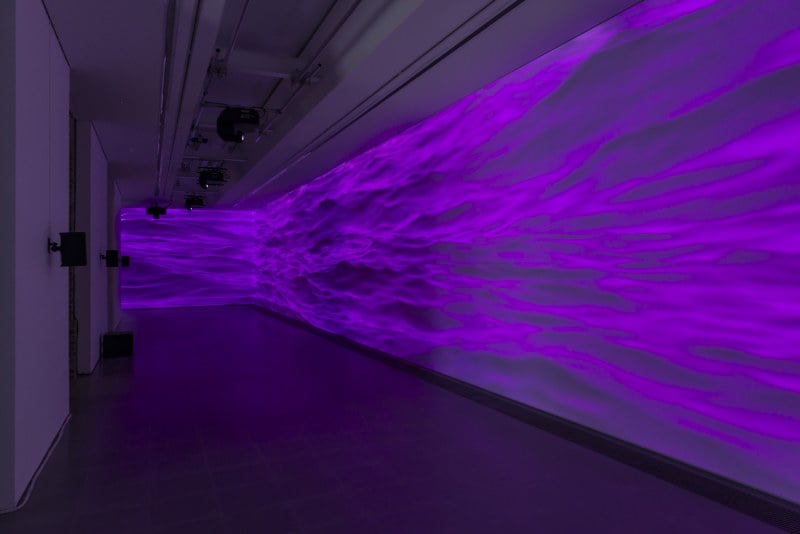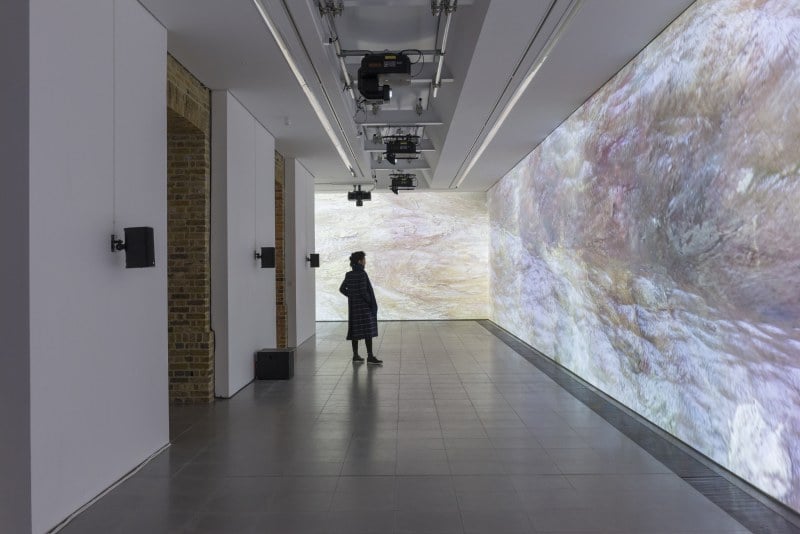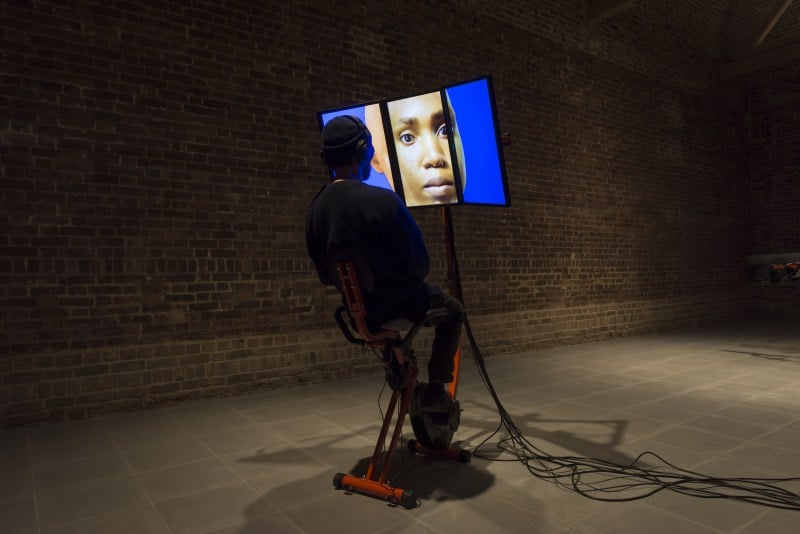Reviews
How Sondra Perry Turned Tech Glitches Into Art About a Broken World at the Serpentine
In "Typhoon Coming On," Perry immerses viewers in J.M.W. Turner's "The Slave Ship," to symbolic effect.

In "Typhoon Coming On," Perry immerses viewers in J.M.W. Turner's "The Slave Ship," to symbolic effect.

Rianna Jade Parker

Upon entering Sondra Perry’s show, “Typhoon coming on,” at London’s Serpentine Gallery, the viewer is washed over by a projection of towering waves mirroring the ocean of J.M.W. Turner’s Slave Ship (Slavers Throwing Overboard the Dead and Dying, Typhoon Coming On) (1840), rendered in Prince purple. With Blender Software, an open-source 3D graphics program, Perry used something called the Ocean Modifier tool to create this Atlantic illusion, animating Turner’s brushstrokes. In Blender, this particular color is the default associated with an error, warning that a file is missing.
Due to dock in Jamaica, the slave ship named Zong left coastal Africa with some 470 captured Africans—much more than the ship could physically hold. In a legal case that won the attention of abolitionists Olaudah Equiano and Granville Sharp, the court found in favor of the owners in their insurance claim related to the loss of over 130 sick and dying human commodities, cast overboard due to a later disproved “water shortage.” The digital immersion of Typhoon coming on (2018) alludes to the 1781 “jettison” as ordered by the Zong’s captain, based on Turner’s famous rendering.

Sondra Perry, installation view, Typhoon coming on, Serpentine Sackler Gallery, London (6 March – 20 May 2018) © 2018 Mike Din. Photo courtesy Serpentine Gallery.
The critic John Ruskin, the first owner of Slave Ship, wrote, “If I were reduced to rest Turner’s immortality upon any single work, I should choose this.” With Typhoon coming on, Perry questions the need to celebrate the physical and visual evidence of brutality, especially against Black people—as if the narrative and generational memory alone were not sufficient. Hence, the error color; something is missing here.

Sondra Perry, installation view, Typhoon coming on, Serpentine Sackler Gallery, London (6 March – 20 May 2018) © 2018 Mike Din. Photo courtesy Serpentine Gallery.
In conversation, Perry speaks about being inspired by artists like Simone Leigh, for her process-based and community-oriented work, so different from the back-biting competition she experienced majoring in sound in sculpture school, and Juliana Huxtable, for her understanding of how identity online is built by a “cutting and pasting” or “morphing” practice of complex self-actualization and self-representation. Perry’s practice also takes inspiration from theorists like Hito Steyerl, whose essay on the changing meaning of visual paradigms in art, “In Free Fall: A Thought Experiment on Vertical Perspective,” inspired Typhoon coming on’s appropriation of the out-of-perspective and off-scale waves of Turner’s painting, and Simone Browne, whose book “Dark Matters: On the Surveillance of Blackness” is quoted in the catalogue, describing the anxieties of total visibility in a world of “CCTV, camera-enabled devices, facial recognition, and other computer vision technologies.”
All these concerns come together within the Serpentine installation in Graft and Ash for a Three-Monitor Workstation (2016). Perry’s own digital avatar greets you across three television screens you view by mounting a bicycle workstation. Bald and brown-skinned, Sondra’s avatar addresses the viewer directly, speaking about the contradictory definitions of success as defined by contemporary capitalism.

Sondra Perry, installation view, Typhoon coming on, Serpentine Sackler Gallery, London. © 2018 Mike Din. Image courtesy the Serpentine.
The software used to render the animated self-portrait in Graft and Ash… had the ability to increase the fat in the simulated face but not on the body. Nor could Perry change her teeth or alter other small details that would allow for something like a fully realized image of self. The work becomes about the incompleteness of digital self-description.

Sondra Perry, Graft and Ash for a Three Monitor Workstation (still) (2016). Image courtesy of the artist.
“I’m not a technologist,” Perry explains. “I like using things up to point that I am pushing and pulling at my own tentative skill level and the boundaries of what a piece of software can do and what its purpose is. If you wanted to actualize yourself as a fat-being, it’s not possible, and that means something.”
Artists using hijacked software and modified iOS emojis to make their mark are creating some of the most engaging art today, in the space where the self engages with prefabricated symbolic possibilities. What this means specifically for those trying to keep alive the revolutionary possibilities of Black subjectivity may be one of the most important areas of investigation of our time.
“Sondra Perry: Typhoon coming on” is on view at the Serpentine Gallery, through May 20, 2018.